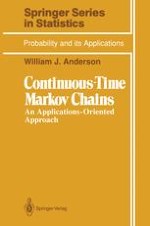
1991 | OriginalPaper | Chapter
Transition Functions and Resolvents
Author : William J. Anderson
Published in: Continuous-Time Markov Chains
Publisher: Springer New York
Included in: Professional Book Archive
Activate our intelligent search to find suitable subject content or patents.
Select sections of text to find matching patents with Artificial Intelligence. powered by
Select sections of text to find additional relevant content using AI-assisted search. powered by
A stochastic process $$\left\{ {\left. {X\left( t \right),t \in \left[ {0, + \infty } \right.} \right\}} \right.$$, defined on a probability space (Ω, F, Pr), with values in a countable set E (to be called the state space of the process), is called a continuous-time parameter Markov chain if for any finite set $$ \leqslant {t_1} < {t_2} < ... < {t_n} < {t_{n + 1}}$$ of “times,” and corresponding set $${i_1},{i_2}...,{i_{n - 1}},i,j$$ of states in E such that $$\Pr \left\{ {X\left( {{t_n}} \right) = i,X\left( {{t_{n - 1}}} \right) = {i_{n - 1}},...X\left( {{t_1}} \right) = {i_1}} \right\} > 0$$, we have (1.1)$$\Pr \left\{ {X\left( {{t_{n + 1}}} \right) = j\left| {X\left( {{t_n}} \right)} \right. = i,X\left( {{t_{n - 1}}} \right) = {i_{n - 1}},...X\left( {{t_1}} \right) = {i_1}} \right\} = \Pr \left\{ {X\left( {{t_{n + 1}}} \right) = j\left| {X\left( {{t_n}} \right) = i} \right.} \right\}.$$ Equation (1.1) is called the Markov property. If for all s, t such that $$ \leqslant s \leqslant t$$ and all i,j ε E the conditional probability $$\Pr \left\{ {X\left( t \right) = j\left| {X\left( s \right)} \right. = i} \right\}$$ appearing on the right-hand side of (1.1) depends only on t − s, and not on s and t individually, we say that the process $$\left\{ {X\left( t \right),t \in \left[ {0, + \left. \infty \right)} \right.} \right\}$$ is homogeneous, or has stationary transition probabilities. In this case, then, $$\Pr \left\{ {X\left( t \right) = j\left| {X\left( s \right) = i} \right.} \right\} = \Pr \left\{ {X\left( {x - s} \right) = j\left| {X\left( 0 \right) = i} \right.} \right\}$$, and the function $${P_{ij}}\left( t \right)\mathop = \limits^{def} \Pr \left\{ {X\left( t \right) = j\left| {X\left( 0 \right)} \right. = i} \right\},ij \in E,t \geqslant 0,$$ is called the transition function of the process.